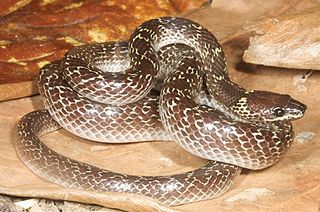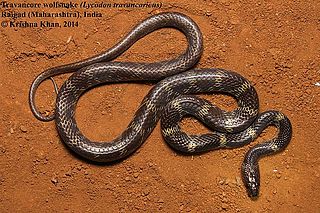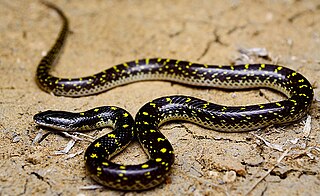
Lycodon aulicus, commonly known as the Indian wolf snake or common wolf snake, is a species of nonvenomous snake found in South Asia and Southeast Asia. Early naturalists have suggested its resemblance to the venomous common krait as an instance of Batesian mimicry.

Lycodon capucinus, also known as the common wolf snake, is a species of colubrid snake, which is commonly found in the Indo-Australian Archipelago. Named after their enlarged front teeth, which gives them a muzzled appearance similar to canines, it also makes the snout somewhat more squarish than other snakes.

Lycodon jara, commonly known as the twin-spotted wolf snake, is a species of colubrid snake. It is endemic to Asia.

Lycodon striatus, commonly known as the northern wolf snake or the barred wolf snake, is a species of nonvenomous colubrid snake from southern Asia.

Lycodon travancoricus, commonly known as the Travancore wolf snake, is a species of colubrid snake endemic to south India.

Lycodon flavomaculatus, commonly called the yellow-spotted wolf snake, is a species of colubrid snake found in the Western Ghats of India.

Lycodon laoensis, commonly known as the Laotian wolf snake, is a species of nonvenomous colubrid snake endemic to Asia.
Lycodon bicolor, commonly known as the Himalayan wolf snake, Mackinnon's wolf snake, or the Mussoorie wolf snake, is a species of snake in the family Colubridae. The species is endemic to Western Himalaya.
Lycodon tiwarii, commonly known as the Andaman wolf snake and Tiwari's wolf snake, is a species of snake in the family Colubridae. The species is native to the Andaman Islands and Nicobar Islands of India.
Lycodon zawi, commonly known as Zaw's wolf snake, is a species of nonvenomous snake in the family Colubridae. The species is native to South Asia and Southeast Asia

Lycodon is a genus of colubrid snakes, commonly known as wolf snakes. The Neo-Latin name Lycodon is derived from the Greek words λύκος (lykos) meaning wolf and οδόν (odon) meaning tooth, and refers to the fang-like anterior maxillary and mandibular teeth. They are nonvenomous, but many members of this genus strongly resemble the venomous kraits in appearance, an example of Batesian mimicry.

Lycodon anamallensis, also known commonly as the Colombo wolf snake is a species of snake in the family Colubridae. The species is endemic to South Asia.
Lycodon alcalai, also known commonly as Alcala's wolf snake, is a species of snake in the family Colubridae. The species is endemic to the Philippines.
Lycodon bibonius, also known as Ota's wolf snake, is a species of colubrid snake found on the islands of Camiguin Norte and Babuyan Claro in the Philippines.
Lycodon solivagus, also known as the common wolf snake, is a species of colubrid snake found on Luzon Island in the Philippines.
Lycodon butleri, also known commonly as Butler's wolf snake, is a species of snake in the family Colubridae. The species is native to southern Thailand and peninsular Malaysia.
Lycodon cardamomensis, also known as the Cardamom Mountains wolf snake, is a species of nonvenomous colubrid snake found in south-western Cambodia and eastern Thailand.
Lycodon cavernicolus, also known as Gua Wang Burma wolf snake, is a species of colubrid snake found in peninsular Malaysia. It was first described in 2014.

Lycodon ruhstrati, also known as Ruhstrat's wolf snake, the mountain wolf snake, or the Formosa wolf snake, is a species of non-venomous colubrid snake found in Taiwan, southern and eastern China, and northern Vietnam.
Oligodon annulifer, also known as the ringed kukri snake, is a colubrid snake endemic to the island of Borneo.










